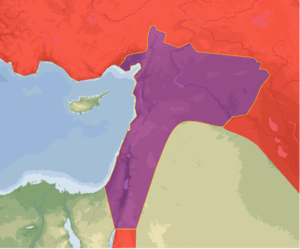Southern Syria

Southern Syria (سوريا الجنوبية, Suriyya al-Janubiyya) is the southern part of the Syria region, roughly corresponding to the Southern Levant. Typically it refers chronologically and geographically to the southern part of Ottoman Syria provinces.[1]
Usage during Ottoman era
Throughout the Ottoman period, prior to World War I, the Levant was administered and viewed locally as one entity, divided into provinces. Southern Syria was thus including the Southern sub-provinces of Ottoman Syria administrative region, including by the end of 19th and early 20th century the Mutasarrifate of Jerusalem, the Sanjak of Nablus and Sanjak of Acre (under Beirut Vilayet from 1888 and previously under Syria Vilayet), and a short-lived Mutasarrifate of Karak (split as a new administrative unit from Syria Vilayet in 1894/5). In 1884, the governor of Damascus made a proposal to establish a new "Vilayet of Southern Syria", though nothing came out of this.[2]
Usage during British and French occupation
In early 20th century, the term "Southern Syria" could imply support for the Greater Syria nationalism associated with the kingdom promised to the Hashemite dynasty of the Hejaz by the British during World War I. After the war, the Hashemite prince Faisal attempted to establish such a Greater Syrian or pan-Mashriq state—a united kingdom that would comprise all of what eventually became Syria, Lebanon, Israel, Jordan, and Palestine, but he was stymied by conflicting promises made by the British to different parties (see Sykes–Picot Agreement), leading to the French creation of the mandate of Syria and Lebanon in 1920.
According to the Minutes of the Ninth Session of the League of Nations' Permanent Mandate Commission, "Southern Syria" was suggested as the name of Mandatory Palestine in the Arabic language. The reports say the following:
"Colonel Symes explained that the country was described as 'Palestine' by Europeans and as 'Falestin' by the Arabs. The Hebrew name for the country was the designation 'Land of Israel', and the Government, to meet Jewish wishes, had agreed that the word "Palestine" in Hebrew characters should be followed in all official documents by the initials which stood for that designation. As a set-off to this, certain of the Arab politicians suggested that the country should be called 'Southern Syria' in order to emphasize its close relation with another Arab State".[3]
In 1927, an Arab party named "the Arab Independence Party in Southern Syria" was established in Mandatory Palestine to emphasize the reaffirmed support for Arab pan-Syrianism.[4]
Later usage
While the use of the term Southern Syria term was common by the early 20th century,[5] it is still occasionally used term in politics, literature and local history of the region.[6][7]
References
- ↑ Kazziha, Walid. The Social History of the Southern Syria (Trans-Jordan) in the 19th and Early 20th Century. Beirut Arab University. 1972.
- ↑ Rogan, Eugene L. (2002-04-11). Frontiers of the State in the Late Ottoman Empire: Transjordan, 1850-1921. Cambridge University Press. pp. 52–55. ISBN 978-0-521-89223-0. Retrieved 2013-06-10.
- ↑ League of Nations, Permanent Mandate Commission, Minutes of the Ninth Session Archived 28 June 2011 at the Wayback Machine. (Arab Grievances), Held at Geneva from June 8th to 25th, 1926,
- ↑ Pipes, D. Greater Syria: The History of an Ambition. Oxford University Press. 1990. p.69.
- ↑ Communication from the Arab Revolt in Southern Syria-Palestine (in Arabic) Archived 14 July 2011 at the Wayback Machine.
- ↑ Jewish colonies on our land in Southern Syria-Palestine, SSNP, 5 March 2009 (in Arabic) Archived 19 June 2010 at the Wayback Machine.
- ↑ Palestine for the Syrians?, Daniel Pipes, Dec. 1986